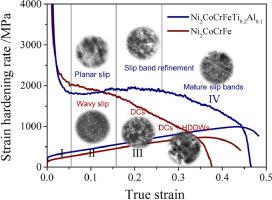Acta Materialia ( IF 8.3 ) Pub Date : 2021-09-14 , DOI: 10.1016/j.actamat.2021.117314 Feng He 1, 2 , Shaolou Wei 1 , Jaclyn Leigh Cann 1 , Zhijun Wang 2 , Jincheng Wang 2 , Cemal Cem Tasan 1

|
In metallic materials, enhancing strain hardening capacity positively affects ductility, fracture toughness, ultimate tensile strength, and other properties. Thus, activating mechanically-induced martensitic transformation or twinning mechanisms has been a captivating goal in the design of steels, titanium alloys, cobalt alloys, complex concentrated alloys (CCAs) and others, through modifications to composition or thermo-mechanical processing. Here instead, we focus on the most basic strain hardening effect, arising from dislocation kinematics, and interactions. For this purpose, we designed two model face centered cubic (FCC) CCAs, Ni2CoCrFe and Ni2CoCrFeTi0.2Al0.1. Both alloys develop single, mechanically-stable, FCC phase microstructures upon processing. Mechanical tests of these alloys reveal that the Al and Ti addition enhances the strain hardening capacity, leading to significant increases in strength and ductility. Microstructure analyses based on electron channeling contrast imaging (ECCI), electron-backscatter diffraction (EBSD), and transmission electron microscopy (TEM) confirm the absence of mechanically-induced twinning and martensitic transformation effects, revealing instead a transition from wavy slip to planar slip. In-situ synchrotron XRD tensile tests are used to discuss the origin of the dislocation glide mode transition and the effects on strain hardening. Based on these analyses, the increased degree of short-range ordering (SRO), rather than the changes in stacking fault energy (SFE), is proposed as the main cause for this transition, and the corresponding effects on strain hardenability.
中文翻译:

机械稳定的面心立方复合浓缩合金中成分相关的滑移平面性及其力学效应
在金属材料中,提高应变硬化能力会对延展性、断裂韧性、极限拉伸强度和其他性能产生积极影响。因此,在钢、钛合金、钴合金、复杂浓缩合金 (CCA) 和其他材料的设计中,通过改变成分或热机械加工,激活机械诱导的马氏体转变或孪生机制一直是一个引人入胜的目标。在这里,我们关注的是最基本的应变硬化效应,由位错运动学和相互作用引起。为此,我们设计了两个模型面心立方 (FCC) CCA,Ni 2 CoCrFe 和 Ni 2 CoCrFeTi 0.2 Al 0.1. 两种合金在加工时都会形成单一的、机械稳定的 FCC 相微观结构。这些合金的机械测试表明,Al 和 Ti 的添加增强了应变硬化能力,从而显着提高了强度和延展性。基于电子通道对比成像 (ECCI)、电子背散射衍射 (EBSD) 和透射电子显微镜 (TEM) 的微观结构分析证实不存在机械诱导孪晶和马氏体转变效应,而是揭示了从波浪滑移到平面滑移的转变. 原位同步加速器 XRD 拉伸试验用于讨论位错滑移模式转变的起源和对应变硬化的影响。基于这些分析,短程有序度 (SRO) 的增加,而不是堆垛层错能 (SFE) 的变化,









































 京公网安备 11010802027423号
京公网安备 11010802027423号